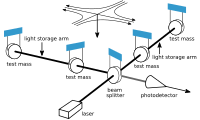Gravitational-wave observatory

Imagine you are sitting on a trampoline, and you have a friend who is also sitting on the trampoline with you. Now, imagine that your friend is holding a heavy bowling ball. As your friend moves the bowling ball around on the trampoline, it causes the trampoline to stretch and bounce up and down. This is kind of like how gravity works.
In space, huge massive objects like black holes also create a "dent" or "ripple" in the fabric of space and time around them. These ripples are called gravitational waves. Scientists have built special machines called gravitational-wave observatories to detect these waves.
The most famous observatory is called LIGO, which stands for Laser Interferometer Gravitational-Wave Observatory. LIGO is made up of two L-shaped buildings, each with a laser beam inside that bounces back and forth between mirrors. The lasers are super precise and can detect even the smallest movements.
If a gravitational wave passes through the observatory, it will cause the mirrors to move ever so slightly. Scientists can measure that movement and use it to detect the gravitational wave. This is like if you were playing catch with your friend on the trampoline and you could feel the difference in how the trampoline moved when the bowling ball was thrown.
Detecting gravitational waves is a big deal because it helps us learn more about the universe and the objects in it. Plus, it's just pretty cool that we can use these fancy machines to "see" something we can't physically see with our eyes.
In space, huge massive objects like black holes also create a "dent" or "ripple" in the fabric of space and time around them. These ripples are called gravitational waves. Scientists have built special machines called gravitational-wave observatories to detect these waves.
The most famous observatory is called LIGO, which stands for Laser Interferometer Gravitational-Wave Observatory. LIGO is made up of two L-shaped buildings, each with a laser beam inside that bounces back and forth between mirrors. The lasers are super precise and can detect even the smallest movements.
If a gravitational wave passes through the observatory, it will cause the mirrors to move ever so slightly. Scientists can measure that movement and use it to detect the gravitational wave. This is like if you were playing catch with your friend on the trampoline and you could feel the difference in how the trampoline moved when the bowling ball was thrown.
Detecting gravitational waves is a big deal because it helps us learn more about the universe and the objects in it. Plus, it's just pretty cool that we can use these fancy machines to "see" something we can't physically see with our eyes.
Related topics others have asked about:
